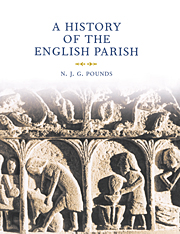Book contents
- Frontmatter
- Contents
- List of illustrations
- Preface
- List of abbreviations
- PART I THE ORIGINS OF THE PAROCHIAL SYSTEM
- PART II THE FUNCTIONS OF THE PARISH
- 5 The parish and its servants
- 6 The economics of the parish
- 7 The parish and the community
- 8 The parish and the church courts: a mirror of society
- 9 The parish church, popular culture and the Reformation
- PART III THE PARISH AND ITS CHURCH
- Notes
- Index
7 - The parish and the community
Published online by Cambridge University Press: 29 July 2009
- Frontmatter
- Contents
- List of illustrations
- Preface
- List of abbreviations
- PART I THE ORIGINS OF THE PAROCHIAL SYSTEM
- PART II THE FUNCTIONS OF THE PARISH
- 5 The parish and its servants
- 6 The economics of the parish
- 7 The parish and the community
- 8 The parish and the church courts: a mirror of society
- 9 The parish church, popular culture and the Reformation
- PART III THE PARISH AND ITS CHURCH
- Notes
- Index
Summary
Common recourse to a single church and common submission
to the demands … of its clergy must have promoted some
degree of community.
Susan ReynoldsThe church, in the countryside at least, was the only tangible
manifestation of the community.
C. S. L. DaviesMuch has been written in recent years about the community in medieval and early modern England. It has been seen, on the one hand, as a homogeneous group co-operating in the arduous business of living; on the other, as a group differing in wealth and status and torn by its internal feuds. The term ‘community’, it has been said, is devoid of precise meaning and is better avoided. Nevertheless, it is difficult to find another word to designate the group of people accidentally thrown together in parish or vill. The village was a structured institution. From Saxon times it had been made up of free men and bondmen, and among the latter there were ‘degrees of unfreedom’. Bondage disappeared in the later Middle Ages, and in its place came an increasing range of wealth, with rich peasants approximating the gentry and, at the bottom of the social ladder, the landless labourers who scarcely lived above subsistence level. Such were the men who were called upon to share amongst themselves the burdens of running their village affairs, apportioning their tax obligations, organising ploughing and commoning routines, raising money for their church, and, no doubt, presenting a common front to their lord.
- Type
- Chapter
- Information
- A History of the English ParishThe Culture of Religion from Augustine to Victoria, pp. 250 - 290Publisher: Cambridge University PressPrint publication year: 2000



